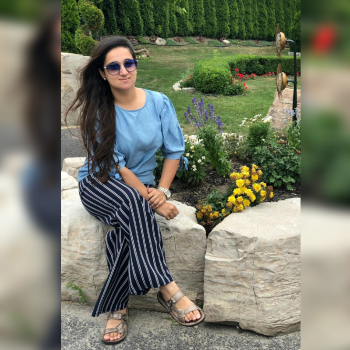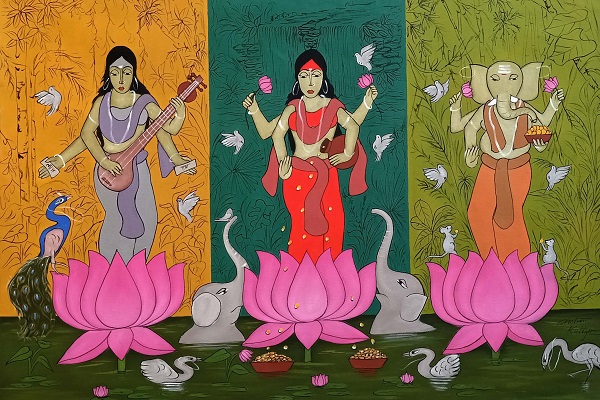
Indian art is a vibrant and diverse field shaped by millennia of rich cultural traditions and religious beliefs. Indian art has always been characterised by a strong respect for the sacred, and many artists use their works to explore and express their spiritual views. The goddesses Lakshmi and Ganesha are among the most prominent subjects in Indian art. Hindus revere these two supernatural beings, Lakshmi and Ganesha, who play an important role in paintings and other art forms, inspiring and influencing many artists.
Lakshmi is the Hindu goddess of fortune, riches, and success. Artists frequently depict Lakshmi paintings in Indian art with four arms. Holding lotus flowers, money, and other symbols of riches and plenty. People believe that worshipping her can bring good fortune and benefits, making her a popular subject for paintings and other forms of art.
Lord Ganesha, on the other hand, is the Hindu deity of fresh beginnings and barrier removal. Ganesha paintings are usually depicted with an elephant's head and a human body, riding a mouse. Ganesha is considered a strong and friendly deity who can help people overcome obstacles and achieve their goals.
Both Lakshmi and Ganesha are shown in Indian art in a variety of ways, from traditional to contemporary. Many artists explore their own spiritual ideas through these holy entities, while others strive to portray the essence of Indian culture and history in their work.
The significance of Lakshmi and Ganesha paintings in Indian art will be discussed in this article. We will talk about the significance of these deities in Hinduism, the common motifs and symbols seen in their paintings, and prominent Indian painters who have made important works representing them.

Lakshmi Paintings
Hindus revere Lakshmi, the goddess of wealth, prosperity, and fortune, as the consort of Lord Vishnu, one of their main deities. Lakshmi is associated with abundance and prosperity, and those who worship her are believed to receive good fortune and blessings.
Indian artists frequently represent Lakshmi with four arms, carrying symbols of riches and plenty like lotus flowers and money. They often depict her alongside other Hindu deities like Ganesha and Saraswati. The lotus flower, a prominent subject in Lakshmi art, represents purity and enlightenment. While the elephant, another typical motif, represents power and strength.
Raja Ravi Varma is a well-known Indian artist who has done Lakshmi paintings. Varma, who was born in 1848, is regarded as one of the best painters in Indian art history. He is well-known for his depictions of Indian mythical and historical figures that are both realistic and detailed. Varma's paintings of Lakshmi stand out for their amazing detail and vivid hues.
Read More: Deciphering Lord Ganesha: An artistic perception
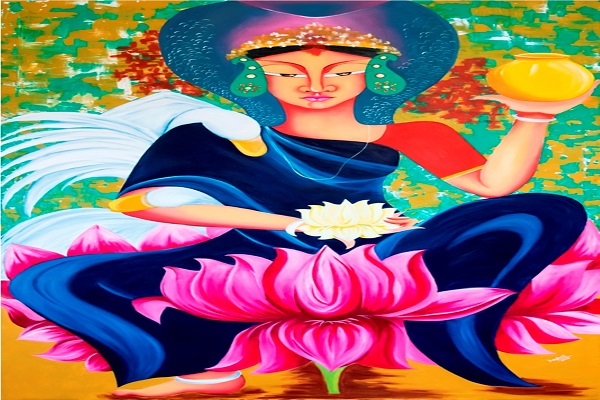
Other notable Indian artists who have created Lakshmi paintings include Amrita Sher-Gil, Jamini Roy, and M.F. Husain. Sher-Gil, who was born in Hungary and raised in India, is known for her powerful depictions of women in Indian society. Her Lakshmi paintings often depict the goddess in a serene and contemplative pose. Which is surrounded by lotus flowers and other symbols of abundance. Jamini Roy, on the other hand, is known for his simplistic and stylized depictions of Indian folk art. His Lakshmi paintings often feature bold, graphic lines and a limited colour palette.
Overall, Lakshmi paintings play an important role in Indian art, reflecting the country's deeply spiritual and cultural traditions. Through their use of vibrant colours and intricate details, these paintings offer a powerful glimpse into the world of Indian mythology and folklore.
Ganesha Paintings

The Hindu deity Ganesha is a symbol of fresh beginnings and barrier removal and is one of the most well-known and adored figures in Indian art. Ganesha is often depicted with an elephant head and human body, riding on a mouse. Hindus believe that Ganesha is the son of two of their most important deities, Lord Shiva and Goddess Parvati.
Hindus associate Ganesha with intelligence, intellect, and achievement and revere him as a powerful and benevolent deity capable of assisting humans in overcoming obstacles and achieving their goals. Indian art often portrays Ganesha with a variety of symbols and themes, including the mouse. Which represents humility and devotion, and the lotus flower, which represents purity and enlightenment.
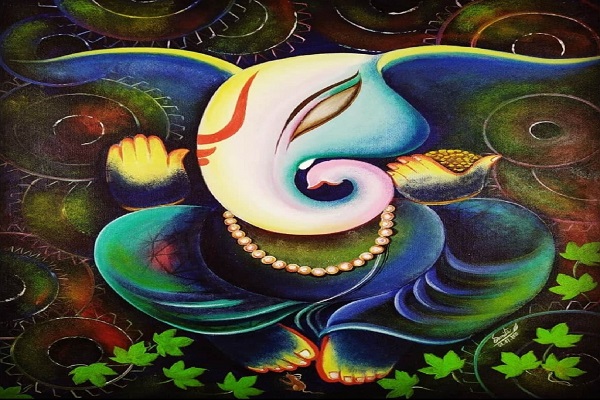
M.F. Husain is a well-known Indian artist who has done Ganesha paintings. Born in 1915, Husain is widely acknowledged as one of the finest artists in the history of Indian art. His Ganesha paintings frequently contain strong, abstract lines and a vibrant colour palette, reflecting the spirit of this revered god in a genuinely one-of-a-kind and compelling way.
Raja Ravi Varma, Jamini Roy, and S.H. Raza are among the other renowned Indian artists who have made Ganesha paintings. Varma's images of Ganesha are frequently rich, vivid colours with meticulous details, but Roy's are basic and stylised, reflecting his experience in Indian folk art. Raza, on the other hand, is well-known for his abstract and geometric paintings, which frequently include Hindu themes and motifs.
Significance of Lakshmi and Ganesha Painting in Indian Art
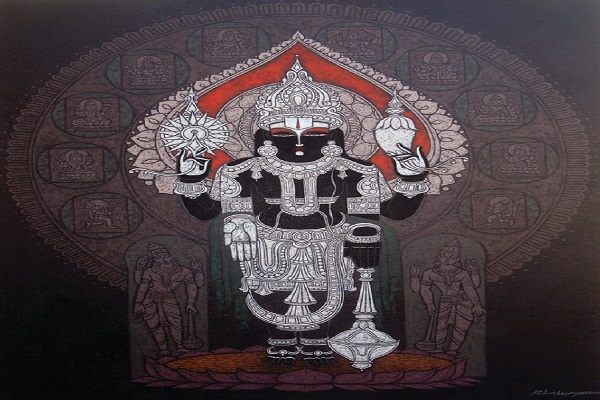
Lakshmi and Ganesha paintings hold great significance in Indian culture and spirituality. These paintings are often used in religious ceremonies and festivals, such as Diwali. In the remark of honouring the deities and invoking their blessings.
Lakshmi and Ganesha paintings have played a vital part in the evolution of Indian art, in addition to their religious significance. These paintings have influenced numerous Indian painters throughout the years with their use of vivid colours, exquisite workmanship, and strong motifs.
Paintings of Lakshmi and Ganesha continue to impact contemporary Indian artists and art. These historical traditions inspire many contemporary artists to create modern renditions of these adored deities. These artists are helping to preserve India's rich cultural history for future generations via their inventive and imaginative approaches to traditional topics.
Interesting Blog: Lakshmi Tanjore Painting: The Rich Indian Culture to Remember
Overview
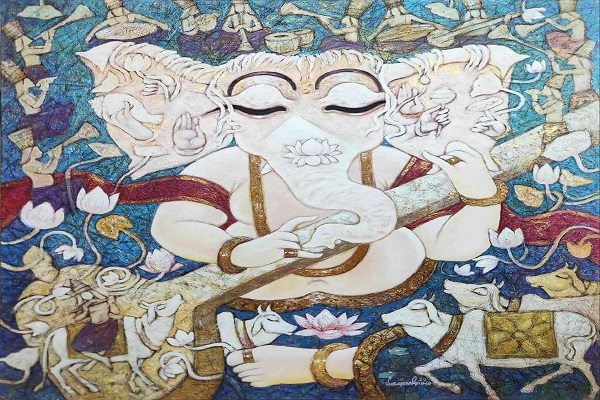
Ganesha and Lakshmi's paintings have a particular position in Indian art and culture. However, these paintings are not only wonderful pieces of art, but they also embody the country's spiritual values and customs. As the goddess of money and success, Lakshmi symbolises riches and good fortune. While Ganesha is revered as the remover of barriers and the deity of fresh beginnings. The lotus flower and the mouse, two themes and symbols seen in these paintings, have great spiritual importance for Hindus.
Furthermore, these paintings have had an impact on current Indian art and artists, providing a source of inspiration and innovation. They have helped to preserve India's rich cultural legacy while also contributing to the creation of new creative forms and methods. Overall, Lakshmi paintings and Ganesha paintings continue to be extremely important in Indian art. And culture. and they will definitely inspire future generations of painters for many years to come.











